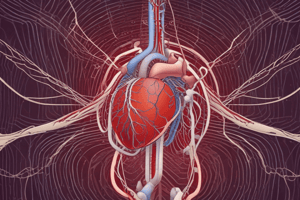Podcast
Questions and Answers
What is the shape of veins during normal function?
What is the shape of veins during normal function?
- Flattened or hourglass (correct)
- Triangular
- Cylindrical
- Oval and round
How does exercise affect the shape of veins?
How does exercise affect the shape of veins?
- Remains unchanged
- Becomes triangular
- Changes to oval and round (correct)
- Becomes more flattened
What maintains blood flow in normal veins?
What maintains blood flow in normal veins?
- Hydrostatic pressure only
- Blood viscosity
- Muscle pump, respiration, and venous valves (correct)
- Vasodilation
How does muscle-related respiration affect venous flow in the legs?
How does muscle-related respiration affect venous flow in the legs?
At what level is hydrostatic pressure 0?
At what level is hydrostatic pressure 0?
What happens to venous flow in the legs during expiration?
What happens to venous flow in the legs during expiration?
What is the effect of Valsalva's Maneuver on blood flow in extremity veins?
What is the effect of Valsalva's Maneuver on blood flow in extremity veins?
During venous duplex imaging, what is evaluated in the transverse plane?
During venous duplex imaging, what is evaluated in the transverse plane?
Which statement regarding venous flow and venous return to the heart is accurate?
Which statement regarding venous flow and venous return to the heart is accurate?
What is the purpose of distal augmentation in spectral Doppler waveform evaluation?
What is the purpose of distal augmentation in spectral Doppler waveform evaluation?
Study Notes
Structure of Veins
- Veins are thin-walled, collapsible, and low-pressure vessels
- Contain semi-lunar valves
- Normally, veins have low pressure and are partially filled with blood, with a flattened or hourglass cross-section
- During exercise, veins change shape to oval and round, allowing them to accommodate more blood and increasing blood flow to the heart
Blood Flow in Veins
- Blood flow in veins is maintained by the combined effect of the muscle pump, respiration, and venous valves
- Hydrostatic pressure is the pressure of the weight of the blood pressing on a vessel, measured at a height above or below heart level
- Hydrostatic pressure is 0 at the level of the heart, decreasing above and increasing below the level of the heart
- Hydrostatic pressure increases intramural pressure, resulting in blood pooling, which needs to be compensated to facilitate venous return
Breathing and Venous Flow
- Venous flow system is a low-pressure system
- Muscle-related respiration changes pressures in the thorax and abdomen
- During inspiration:
- Diaphragm descends, increasing pressure in the abdominal cavity and decreasing venous flow in the legs
- Pressure in the thorax decreases, increasing venous flow in the head, arms, and vena cava
- During expiration:
- Diaphragm ascends, increasing pressure in the thoracic cavity and decreasing venous flow in the head, arms, and vena cava
- Venous flow in the legs increases due to decreased abdominal pressure
- Changes in venous flow to the heart are opposite to venous flow in the legs
Response to Valsalva's Maneuver
- Deep inspiration followed by bearing down results in cessation of blood flow in both upper and lower extremity veins
- No flow occurs during Valsalva's maneuver
- Increased velocities are seen after completing the Valsalva, confirming the competency of the valves system
Evaluation of Lower Extremity Veins
- Divided into two categories: non-invasive and invasive
- Non-invasive venous evaluation:
- Duplex sonography
- Technical aspects of venous duplex imaging:
- Carried out in both transverse and sagittal planes
- Transverse plane: venous lumen is evaluated by compressions on gray scale imaging
- Sagittal plane: spectral Doppler wave form is studied using Valsalva's maneuver, proximal compression, and distal augmentation
Studying That Suits You
Use AI to generate personalized quizzes and flashcards to suit your learning preferences.
Description
Test your knowledge on the structure and function of veins, including their thin-walled nature, presence of semi-lunar valves, and changes in shape during exercise. Learn about how veins accommodate more blood and maintain blood flow during normal and active states.




